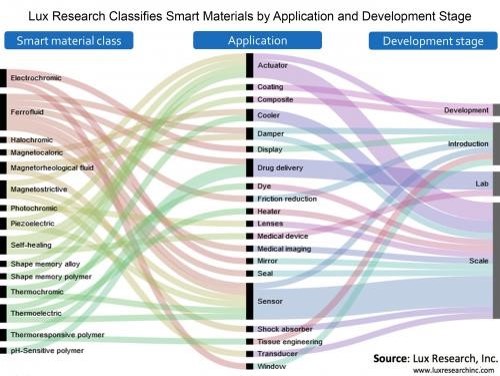Self-healingCoatings and Parts Are Next Frontier for Smart Materials
Thanks to recentadvances in modeling and design, development of smart materials will becomefaster and cheaper in the next five to 10 years, says Lux Research.
BOSTON, MA – October 20, 2015 – Recentadvances and ongoing improvements will help rapid and low-cost development ofsmart materials, and the next wave of innovation will be in self-healingcoatings and parts, according to LuxResearch.
Smart materials –those that change their properties in response to environmental stimuli,providing dynamic functionality – range from everyday items like photochromiclenses that darken in sunlight to complex ceramics and nanocomposites used inelectronics. Emerging classes of smart materials include self-healingmaterials, sensing materials, and shape memory materials, each of which hasmany potential applications.
“Today, researchers are beginning todevelop software tools for predicting what structures will result in what smartproperties. As a result, in the next five to ten years, these kinds of smartmaterials may become much faster and cheaper to develop,” said Anthony Vicari,Lux Research Analyst and the lead author of the report titled, “Get Smart: Smart Materials as a Design Paradigm.”
Lux Researchanalysts studied advances in the development of smart materials and theiradoption by industry. Among their findings:
a. Focus is on self-healing materials. With applications in composites andcoatings, self-healing materials are set to be the next frontier for smartmaterials. Such materials automatically repair damage to themselves through oneof several chemical mechanisms.
b. Varied companies hold patents. Over 300,000 patents have beengranted across all smart material families even though few mention the term“smart material” in their titles, abstracts or claims. Patent filings peaked in2012 at about 100,000, and top patent holders include heavyweights such asSiemens, IBM, GE, and Samsung.
·
Commercialization can occur rapidly whenconditions are right. Many classes of smart materials had long incubationtimes, but saw very rapid commercialization once the time was right. Pieozelectricmaterials were long relegated to niche applications before booming due toadoption in mainstream products such as inkjet printers, digital cameras andsmartphones.
The report, titled “Get Smart: SmartMaterials as a Design Paradigm,” is part of the Lux Research Advanced Materials Intelligence service.

以下是全文翻译:
波士顿——Lux Research在一份新报告中指出,新近的技术进展和持续改进将有助于以快速而低成本的方式开发出智能材料。下一波将是自修复涂料及部件的创新。那些可以根据环境刺激因素而改变性能的智能材料,提供了动态的功能。这些智能材料既包括日常用品如颜色会在阳光下变深的光致变色镜片,也包括电子产品中所用的复杂陶瓷和纳米复合材料。新兴的智能材料类包括自修复材料、传感材料及形状记忆材料。
该报告主要作者,也是Lux Research公司分析师Anthony Vicari介绍说:“目前,研究人员开始开发软件工具,用以预测什么样的结构将具有智能特性。因此,未来5-10年,这些类型的智能材料开发速度将变得更快,成本更低”。Lux Research分析师研究了智能材料的研发进展,以及它们在工业中的应用,发现侧重点在自修复材料方面。用于复合材料和涂料的自修复材料将成为新一代前沿智能材料。这类材料可以通过几种化学机理中的一种,对自身的损害进行自动修复。
该研究同时还发现,不同公司都拥有专利。超过300000项专利已经授予所有智能材料家族,尽管很少在标题、概述或者声明中提到“智能材料”这一术语。智能材料的专利申报在2012年达到高峰,约有100000项。拥有最多专利的专利持有者包括西门子、IBM、GE和三星等公司。
研究人员还报告,一旦条件具备,即可很快投入商业化生产。很多等级的智能材料孵化时间很长,一旦时机到了,可以很快商业化。压电材料在主流产品如喷墨打印机、数码相机和智能手机等得到广泛应用前,很长时间都只限于小众应用。题为“走向智能化:智能材料成为设计典范”的研究报告是Lux Research公司提供的先进材料情报服务的一部分。